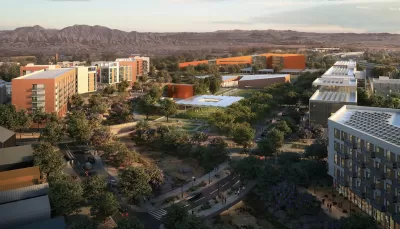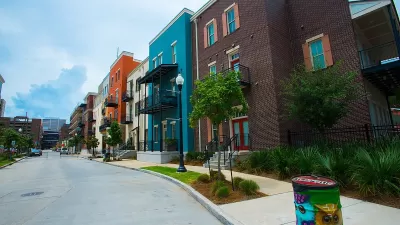The project is part of an initiative to build affordable housing on shuttered golf courses.

A former golf club in Las Vegas will be redeveloped into the largest affordable housing project in Nevada history, reports Christian Hudspeth for KTNV.
The project is being kickstarted by a $25 million loan from the State Infrastructure Bank. “The state said the first phase of the Desert Pines redevelopment will cost around $57.3 million, and $450 million overall.”
The project will provide over 1,000 affordable multifamily housing units and 280 market-rate homes. It will also include a community center early education center, job training center, and commercial space. “According to a release from the Nevada State Treasurer's Office, the master-planned community will support East Las Vegas with nearly 1,400 new homes and close to 7,400 jobs for the community.”
The work required for the project offers some of the strongest labor protections in the state, including a Project Labor Agreement, a mandate to hire at least 50 percent local Nevada residents, a prevailing wage rate, and other requirements.
FULL STORY: This East Las Vegas affordable housing project will be the largest in state history

Americans May Be Stuck — But Why?
Americans are moving a lot less than they once did, and that is a problem. While Yoni Applebaum, in his highly-publicized article Stuck, gets the reasons badly wrong, it's still important to ask: why are we moving so much less than before?

Using Old Oil and Gas Wells for Green Energy Storage
Penn State researchers have found that repurposing abandoned oil and gas wells for geothermal-assisted compressed-air energy storage can boost efficiency, reduce environmental risks, and support clean energy and job transitions.

Placekeeping: Setting a New Precedent for City Planners
How a preservation-based approach to redevelopment and urban design can prevent displacement and honor legacy communities.

San Francisco’s Muni Ridership Grew in 2024
The system saw its highest ridership since before the Covid-19 pandemic, but faces a severe budget shortage in the coming year.

Colorado Lawmakers Move to Protect BRT Funding
In the face of potential federal funding cuts, CDOT leaders reasserted their commitment to planned bus rapid transit projects.

Safe Streets Funding in Jeopardy
The Trump administration is specifically targeting bike infrastructure and other road safety projects in its funding cuts.
Urban Design for Planners 1: Software Tools
This six-course series explores essential urban design concepts using open source software and equips planners with the tools they need to participate fully in the urban design process.
Planning for Universal Design
Learn the tools for implementing Universal Design in planning regulations.
Heyer Gruel & Associates PA
City of Moreno Valley
Institute for Housing and Urban Development Studies (IHS)
City of Grandview
Harvard GSD Executive Education
Salt Lake City
NYU Wagner Graduate School of Public Service
City of Cambridge, Maryland





























